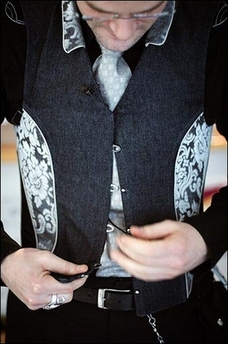Men lace up their corsets
(AFP)Updated: 2007-02-15 10:10
PARIS - After skirts, make-up and pantyhose for men, the corset, onetime symbol of women's oppression, might be the next big thing for fashion-conscious males.
 A man adjusts a corset at an exhibit dedicated to the garment in Paris, 12 February 2007. [AFP]  |
Young Parisian corset maker Sylvain Nuffer began cutting, stitching and boning corsets for men four years ago and now sells 30-odd standard models a year at 500 to 600 euros (650 to 775 dollars) a shot, 40 percent more when made to measure.
"I felt frustrated by the lack of choice of clothing for men," he told AFP. "I made one for myself and they kind of multiplied."
Wearing jeans with a gray silk corset of his own making over a shirt and tie, Nuffer, who learnt the complex trade with his corsetiere mother, stands tall, waist nipped in, shoulders wide, back straight.
Corsets for men have a history, he said, worn by medieval horsemen to protect the spine, adopted by bikers today for the same reason.
But the real inspiration behind Nuffer's corset - laced up the back with a clip-open busk at the front - dates back to the heady days of the 1789 French Revolution.
Male followers of utopian philosopher and economist, Count Claude Henri de Saint-Simon, at the time adopted the corset precisely because it was impossible to lace up alone. Having to help each other with the ties symbolised the humanitarian helping-other ideals of the Saint-Simonien movement.
Critics derided Nuffer's early creations, however, saying a garment stiffened with a multitude of bones and stays would be uncomfortable.
Not so, said one adept, Laurent Renaud, who teaches at a fashion school and wears his everyday. "I wear it over a shirt or under a sweater," he said. "I use it as daywear or to go out at night."
"The problem," he added, "is you get so used to it keeping you straight that it gets difficult to go without."
Hubert Barrere, the designer who created the corset for Madonna's wedding dress in 2000, said in interview that "corsets for men are a bit like upgraded waistcoats."
Military dress uniforms continued to be ribbed in the 20th century, said Barrere, a master corset maker who works with likes of Dolce and Gabbana and Stella McCartney while turning out made-to-measure personal numbers for Madonna, Kylie Minogue and Isabelle Adjani.
"I'm not over-enthused about corsets for men," he added. "I prefer a woman's body, I feel better highlighting a woman's curves."
Pulling from a box a gold python corset made for Alexander McQueen and worn by Naomi Campbell, Barrere waxes lyrical on what a corset can do for a woman.
"A woman who wears a corset offers herself to men differently, she is attractive," he said. "Corsets constrain the body, either to protect or to display, and the richer and more powerful you are, the readier you are to wear clothing that constrains."
Barrere, whose bespoke corsets cost over 2,000 euros a piece, uses spring or spiral steel rather than plastic to "change a silhouette, highlight feminine shapes, modify volumes."
"I want corsets to be comfortable, delirious but comfortable."
Whether as underwear or outerwear, the corset has seen difficult times.
Worn to gird and shape the torso, 16th-century models were so stiff women could not sit down. At mealtimes, wearers had to remove the wooden busk, or shaft, inserted at the front and lay it at the table by the cutlery. It was a breach of etiquette for a man to handle the busk.
In the 19th century, when waists were supposed to be no bigger than twice the circumference of the neck, there was an outcry over the harm of tight lacing to health and corsets fell out of favour as an instrument of women's oppression.
They were gradually replaced, as underwear, by girdles and elastic bras while the corset, worn outside the clothing, was marginalised as an accounterment in the dusky subcultures of bondage, domination, sadism and masochism.
In the 1970s the garment came out of the closet, staging a comeback on the catwalks in a collection by Britain's Vivienne Westwood inspired by historical garments.
She was followed a decade later by Thierry Mugler and Jean-Paul Gaultier, the designer who created Madonna's famed pointy corset bra for her 1990 World Tour and then turned the shape into an iconic perfume bottle.
For Barrere, the corset story has come full circle.
"Corsets were long a wound for women," he said. "But today if a woman decides to wear a corset it is a sign of empowerment, not of submission."
|
||
|
||
|
|